Risks of Vaginal Delivery Following Caesarean Section
Added on 2023-05-26
51 Pages11873 Words292 Views
Running head: EVIDENCE BASED NURSING RESEARCH
EVIDENCE BASED NURSING RESEARCH: RISKS OF VAGINAL DELIVERY
FOLLOWING CAESEREAN SECTION
Name of the Student:
Name of the University:
Author note:
EVIDENCE BASED NURSING RESEARCH: RISKS OF VAGINAL DELIVERY
FOLLOWING CAESEREAN SECTION
Name of the Student:
Name of the University:
Author note:
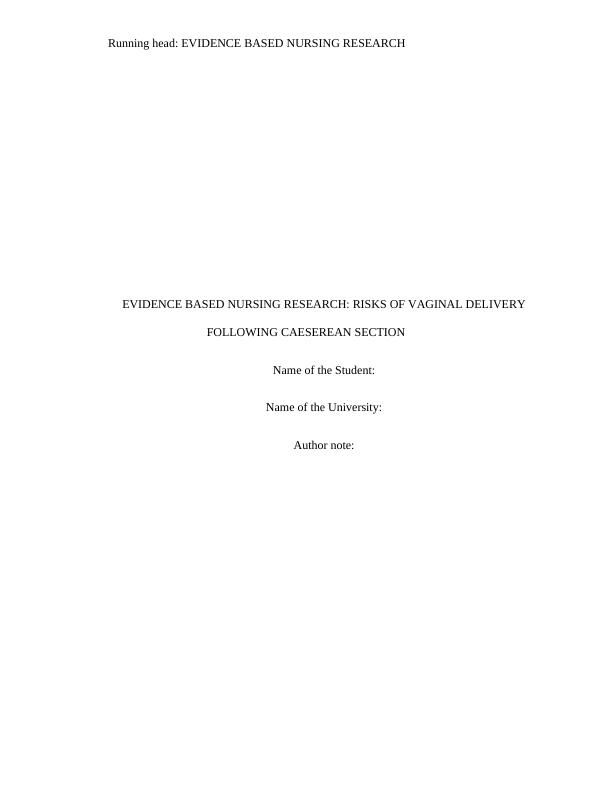
1EVIDENCE BASED NURSING RESEARCH
Executive Summary:
A common myth about caesarean delivery states that a woman who had previously
underwent a C-section must undergo caesarean delivery in subsequent pregnancies. However,
the findings of the research studies have rendered the myth completely obsolete. It has been
reported that women who had previously underwent a C-section could attempt for a safe vaginal
delivery in the subsequent pregnancies. It should also be mentioned in this regard that a vaginal
delivery after C-section is accompanied with a significant number of risk factors, that include,
uterine rupture, surgical cite infection and poor maternal and fetal health outcome. This paper
intends to conduct an exhaustive systematic review on the available literatures that assesses the
risks involved in a vaginal delivery after a C-section.
Executive Summary:
A common myth about caesarean delivery states that a woman who had previously
underwent a C-section must undergo caesarean delivery in subsequent pregnancies. However,
the findings of the research studies have rendered the myth completely obsolete. It has been
reported that women who had previously underwent a C-section could attempt for a safe vaginal
delivery in the subsequent pregnancies. It should also be mentioned in this regard that a vaginal
delivery after C-section is accompanied with a significant number of risk factors, that include,
uterine rupture, surgical cite infection and poor maternal and fetal health outcome. This paper
intends to conduct an exhaustive systematic review on the available literatures that assesses the
risks involved in a vaginal delivery after a C-section.
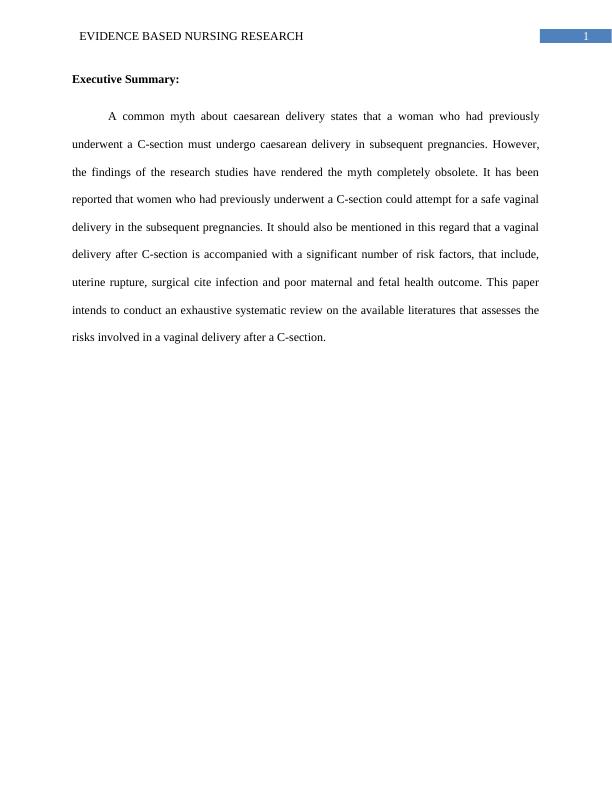
2EVIDENCE BASED NURSING RESEARCH
Table of Contents
Chapter 1..............................................................................................................................4
Introduction:........................................................................................................................4
Background:.....................................................................................................................5
Problem Statement:..........................................................................................................6
Research Aims and Objectives........................................................................................7
Aim..................................................................................................................................7
Research Question...........................................................................................................7
Objectives........................................................................................................................7
Research Rationale:.........................................................................................................9
Research Methodology..................................................................................................10
Chapter 2............................................................................................................................11
Methodology:.....................................................................................................................11
Justification:...................................................................................................................12
Literature Search:...........................................................................................................12
Key words:.....................................................................................................................12
Chapter 3............................................................................................................................20
Literature Review:.............................................................................................................20
Chapter 4............................................................................................................................26
Table of Contents
Chapter 1..............................................................................................................................4
Introduction:........................................................................................................................4
Background:.....................................................................................................................5
Problem Statement:..........................................................................................................6
Research Aims and Objectives........................................................................................7
Aim..................................................................................................................................7
Research Question...........................................................................................................7
Objectives........................................................................................................................7
Research Rationale:.........................................................................................................9
Research Methodology..................................................................................................10
Chapter 2............................................................................................................................11
Methodology:.....................................................................................................................11
Justification:...................................................................................................................12
Literature Search:...........................................................................................................12
Key words:.....................................................................................................................12
Chapter 3............................................................................................................................20
Literature Review:.............................................................................................................20
Chapter 4............................................................................................................................26
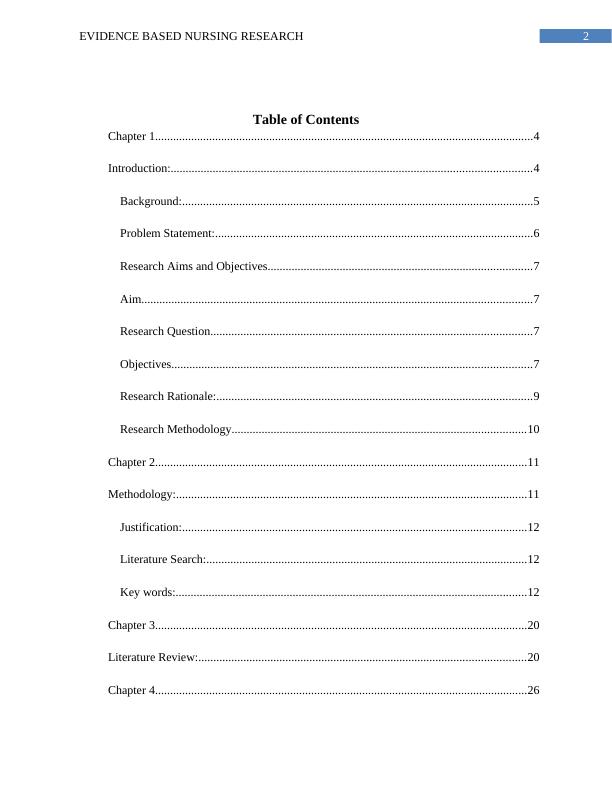
3EVIDENCE BASED NURSING RESEARCH
Analysis:........................................................................................................................26
GRADE Assessment:.....................................................................................................26
Chapter 5............................................................................................................................39
Conclusion:........................................................................................................................39
Recommendations:............................................................................................................42
References:........................................................................................................................43
Grade Adapted Grade Approach Table:............................................................................48
Analysis:........................................................................................................................26
GRADE Assessment:.....................................................................................................26
Chapter 5............................................................................................................................39
Conclusion:........................................................................................................................39
Recommendations:............................................................................................................42
References:........................................................................................................................43
Grade Adapted Grade Approach Table:............................................................................48
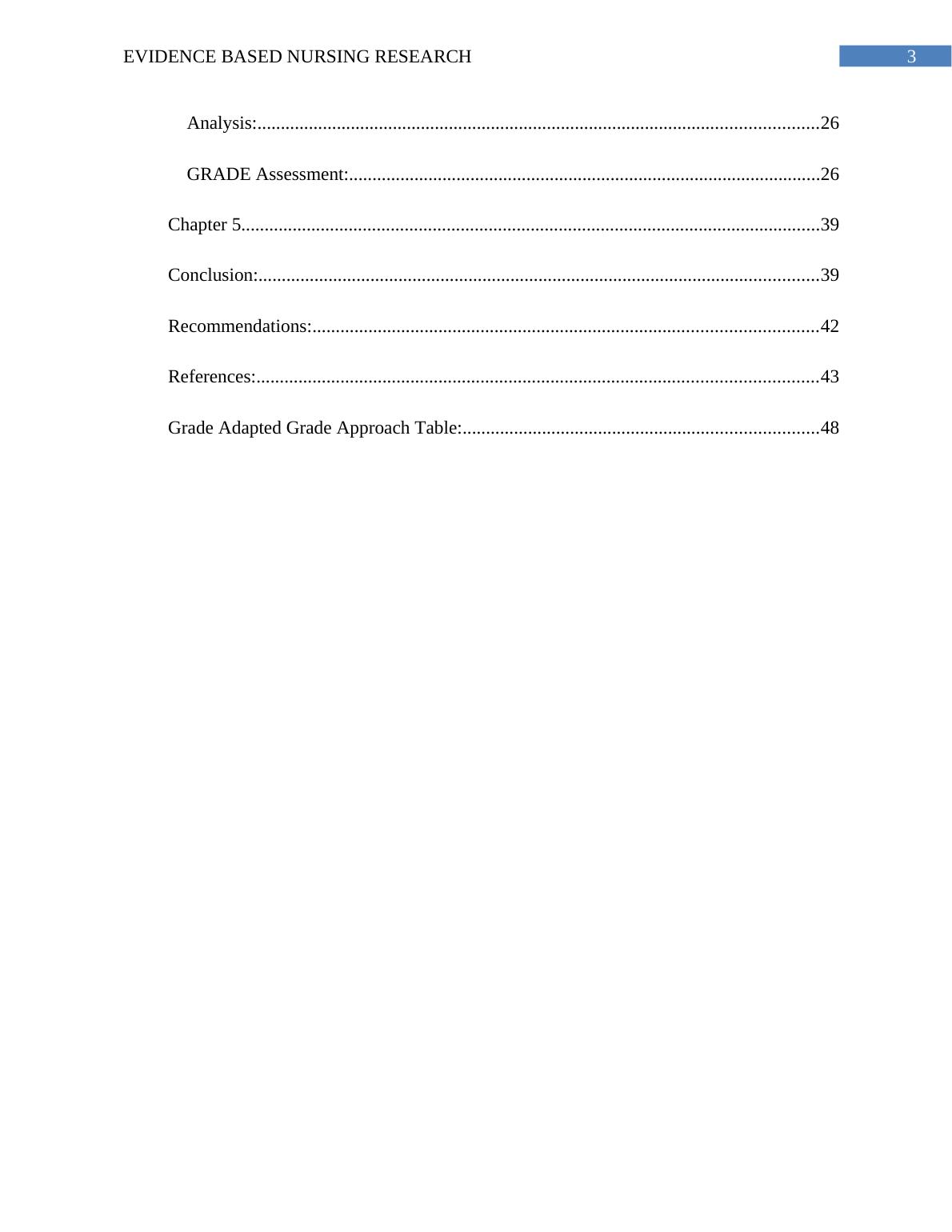
4EVIDENCE BASED NURSING RESEARCH
Chapter 1
Introduction:
While the deliverance of a baby is greeted with excitement and positivity from the
concerned family, the process itself can be rather cumbersome and complicated for the mother. A
number of infant delivery options are available at present. While each procedure brings with
itself, a unique set of advantages and complications, the health and safety of the baby and the
mother, must always be priorities during the final confirmation of the chosen method. While
there may be specific preferences presented by the parents for the delivery of the baby, it is
however, always advised to opt for procedures suggested by the associated medical professional.
The types of delivery methods which are available nowadays include: vaginal delivery, forceps
delivery, caesarean section, vacuum extraction and vaginal birth after caesarean (VBAC) (Chu et
al. 2017).
This research will aim to focus on the risks and complications associated with vaginal
birth after extraction as the chosen method for delivery of the infant. At present, a number of
women are opting for VBAC and it has been documented that women undertaking vaginal
delivery after C-section have a success rate of 60 to 80%, due to the onset of advancements in
medical science and technology in obstetrics (Sabol, Denman and GUISE 2015.). In comparison
to a caesarean mode of infant delivery, a vaginal delivery brings forth a number of advantages
such as lack of surgery or the complications of the placenta associated with surgery, a hospital
stay of short duration and a faster recovery rate of undertaking daily life activities (Regan et al.
2015).
Chapter 1
Introduction:
While the deliverance of a baby is greeted with excitement and positivity from the
concerned family, the process itself can be rather cumbersome and complicated for the mother. A
number of infant delivery options are available at present. While each procedure brings with
itself, a unique set of advantages and complications, the health and safety of the baby and the
mother, must always be priorities during the final confirmation of the chosen method. While
there may be specific preferences presented by the parents for the delivery of the baby, it is
however, always advised to opt for procedures suggested by the associated medical professional.
The types of delivery methods which are available nowadays include: vaginal delivery, forceps
delivery, caesarean section, vacuum extraction and vaginal birth after caesarean (VBAC) (Chu et
al. 2017).
This research will aim to focus on the risks and complications associated with vaginal
birth after extraction as the chosen method for delivery of the infant. At present, a number of
women are opting for VBAC and it has been documented that women undertaking vaginal
delivery after C-section have a success rate of 60 to 80%, due to the onset of advancements in
medical science and technology in obstetrics (Sabol, Denman and GUISE 2015.). In comparison
to a caesarean mode of infant delivery, a vaginal delivery brings forth a number of advantages
such as lack of surgery or the complications of the placenta associated with surgery, a hospital
stay of short duration and a faster recovery rate of undertaking daily life activities (Regan et al.
2015).
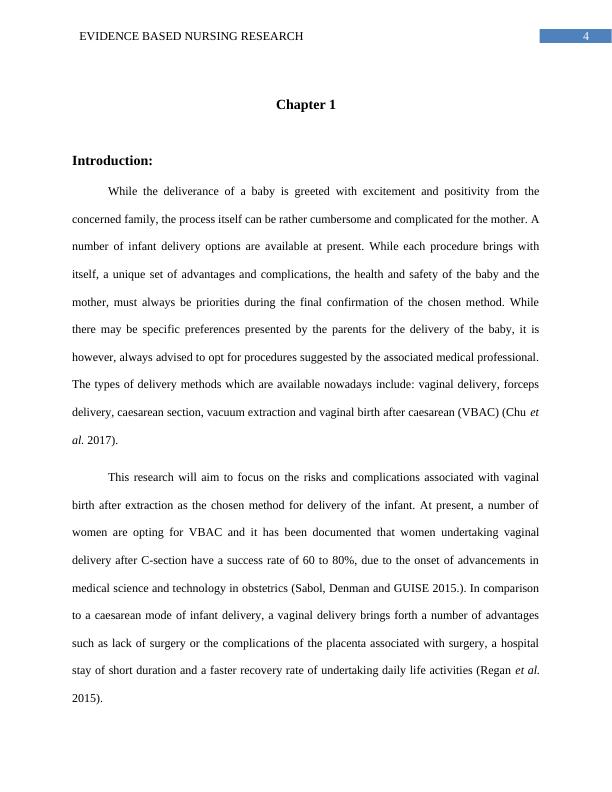
5EVIDENCE BASED NURSING RESEARCH
However, it is worthwhile to note that after a C-section, the possibilities of a undertaking
a vaginal delivery by the mother decreases due to the susceptibilities of complications. An
unsuccessful vaginal labour after caesarean section may often lead to complications such as
rupturing of the uterus which is characterized by the uterus tearing (Tilden et al. 2017). This not
only leads to fatal complications in the delivery of the baby but also presents a life threatening
complicating in the mother, who may suffer from excessive bleeding. To prevent the bleeding, a
caesarean section may be performed as an emergency (Mone et al. 2014). Likewise, there may
be requirement of a hysterectomy, further ending the future possibilities of the mother to undergo
conception. Hence, prior to undertaking a second vaginal delivery, the associated health
professional must thoroughly evaluate the medical history of the mother and the possible risks
(Dhillon et al. 2017).
Background:
Vaginal Delivery:
The process of vaginal delivery can be explained as the medium of giving birth to babies
through the vagina. The method is common in all mammals except in monotremes that lay eggs
within the external environment. In case of humans, this method is commonly used for the
delivery of the baby. It should be noted here that the length of hospital stay for a normal vaginal
delivery is in between 36 to 48 hours. On the other hand, the length of hospital stay with an
epistomy (a surgical incision to widen vaginal opening) is generally in between 48 to 60 hours
and for a C-section it is in between 72 to 108 hours. Vaginal delivery can be of various kinds
depending upon the type of labor pain and are known with different terms that include,
spontaneous vaginal delivery, assisted vaginal delivery, induced vaginal delivery and normal
vaginal delivery.
However, it is worthwhile to note that after a C-section, the possibilities of a undertaking
a vaginal delivery by the mother decreases due to the susceptibilities of complications. An
unsuccessful vaginal labour after caesarean section may often lead to complications such as
rupturing of the uterus which is characterized by the uterus tearing (Tilden et al. 2017). This not
only leads to fatal complications in the delivery of the baby but also presents a life threatening
complicating in the mother, who may suffer from excessive bleeding. To prevent the bleeding, a
caesarean section may be performed as an emergency (Mone et al. 2014). Likewise, there may
be requirement of a hysterectomy, further ending the future possibilities of the mother to undergo
conception. Hence, prior to undertaking a second vaginal delivery, the associated health
professional must thoroughly evaluate the medical history of the mother and the possible risks
(Dhillon et al. 2017).
Background:
Vaginal Delivery:
The process of vaginal delivery can be explained as the medium of giving birth to babies
through the vagina. The method is common in all mammals except in monotremes that lay eggs
within the external environment. In case of humans, this method is commonly used for the
delivery of the baby. It should be noted here that the length of hospital stay for a normal vaginal
delivery is in between 36 to 48 hours. On the other hand, the length of hospital stay with an
epistomy (a surgical incision to widen vaginal opening) is generally in between 48 to 60 hours
and for a C-section it is in between 72 to 108 hours. Vaginal delivery can be of various kinds
depending upon the type of labor pain and are known with different terms that include,
spontaneous vaginal delivery, assisted vaginal delivery, induced vaginal delivery and normal
vaginal delivery.

6EVIDENCE BASED NURSING RESEARCH
C-section:
C-section or Caesarean section can be defined as the use of surgery to facilitate delivery.
It should be mentioned that a caesarean section is usually performed on sensing a risk with the
normal delivery method. In general, caesarean section is devised in complex situations such as
twin pregnancy, obstructed labor, breech-birth, higher blood pressure of the mother or
complications with the umbilical cord. C-section is generally performed on the basis of the
mother’s pelvis structure or a prior C-section history. It should be noted that a trial period post
C-section is possible, however it is laden with critical complications. Research studies
recommend that C-section should only be performed under medical emergencies. However, the
method in modern times has become popular and is performed upon request by expecting
mothers and their families. The process is performed within an hour and is usually performed
with the spinal block. The patient is anaesthetized and a urinary catheter is utilized in order to
drain the content of the bladder. The abdominal skin is then cleaned with an antiseptic and an
incision is then made. The length is generally about 12 cm in length and after the delivery of the
baby, the incision is stitched. The patient can start breastfeeding on recovering her senses and
can be discharged from the hospital after some days.
Problem Statement:
A normal established notion believes that mothers who had once been subjected to a C-
section would have to undergo the same procedure during their second pregnancy. However,
recent findings have stated that women who had previously undergone caesarean delivery could
safely opt for a trial of labor in order to have normal vaginal deliveries in the next phase of
pregnancy. Studies have identified a number of benefits associated with the trail of labor post C-
section. The benefits incorporate a shorter duration of hospital stay along with postpartum
C-section:
C-section or Caesarean section can be defined as the use of surgery to facilitate delivery.
It should be mentioned that a caesarean section is usually performed on sensing a risk with the
normal delivery method. In general, caesarean section is devised in complex situations such as
twin pregnancy, obstructed labor, breech-birth, higher blood pressure of the mother or
complications with the umbilical cord. C-section is generally performed on the basis of the
mother’s pelvis structure or a prior C-section history. It should be noted that a trial period post
C-section is possible, however it is laden with critical complications. Research studies
recommend that C-section should only be performed under medical emergencies. However, the
method in modern times has become popular and is performed upon request by expecting
mothers and their families. The process is performed within an hour and is usually performed
with the spinal block. The patient is anaesthetized and a urinary catheter is utilized in order to
drain the content of the bladder. The abdominal skin is then cleaned with an antiseptic and an
incision is then made. The length is generally about 12 cm in length and after the delivery of the
baby, the incision is stitched. The patient can start breastfeeding on recovering her senses and
can be discharged from the hospital after some days.
Problem Statement:
A normal established notion believes that mothers who had once been subjected to a C-
section would have to undergo the same procedure during their second pregnancy. However,
recent findings have stated that women who had previously undergone caesarean delivery could
safely opt for a trial of labor in order to have normal vaginal deliveries in the next phase of
pregnancy. Studies have identified a number of benefits associated with the trail of labor post C-
section. The benefits incorporate a shorter duration of hospital stay along with postpartum
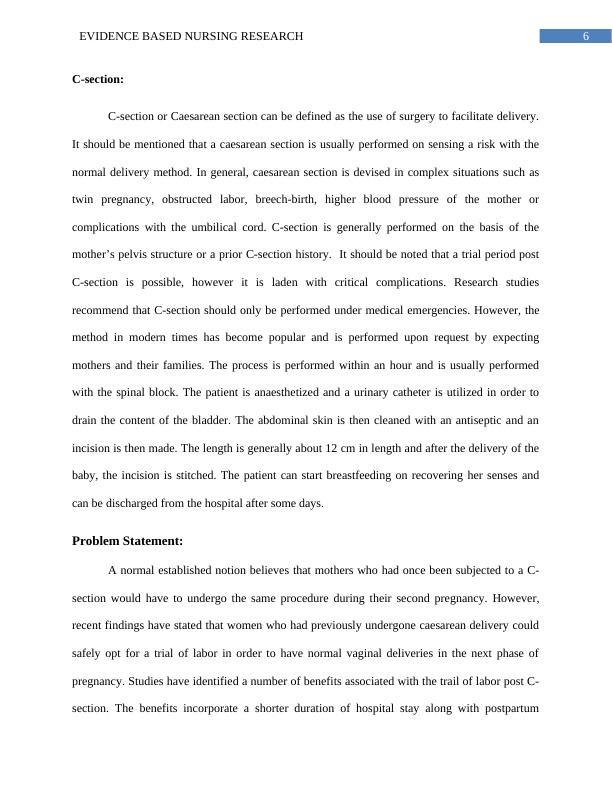
7EVIDENCE BASED NURSING RESEARCH
recovery. In addition to this, fewer incidences of complications such as postpartum fever, uterine
infection and thromboembolism within the lungs and the leg has also been identified that require
frequent blood transfusion. Also, vaginal birth after C-section has been identified to cause fewer
breathing problems within babies. It should also be stated here that vaginal delivery has also
been identified with a number of risks that include risk of fetal death and a ruptured uterus
resulting in a critical condition. The fetal death rate through vaginal delivery after a successful C-
section has been reported to be higher which indicates the need to investigate and evaluate the
risks associated with vaginal delivery post C-section. It should be mentioned here that the
research study and the findings would help in designing the best intervention strategies and
practices so as to foster effective maternal and fetal health outcome.
Research Aims and Objectives
Aim
The aim of the following research is to determine the risks associated with vaginal
delivery as second procedure in pregnant mothers who have undertaken caesarean section
previously for the implementation of safe infant delivery practices at the local level.
Research Question
What are the risks of a subsequent vaginal delivery following a caesarean section?
Objectives
As per the aim of the research, the objectives of the following research are the following:
To critical examine and analyze the risk factors which militate vaginal delivery as second
procedure after previous caesarean section.
recovery. In addition to this, fewer incidences of complications such as postpartum fever, uterine
infection and thromboembolism within the lungs and the leg has also been identified that require
frequent blood transfusion. Also, vaginal birth after C-section has been identified to cause fewer
breathing problems within babies. It should also be stated here that vaginal delivery has also
been identified with a number of risks that include risk of fetal death and a ruptured uterus
resulting in a critical condition. The fetal death rate through vaginal delivery after a successful C-
section has been reported to be higher which indicates the need to investigate and evaluate the
risks associated with vaginal delivery post C-section. It should be mentioned here that the
research study and the findings would help in designing the best intervention strategies and
practices so as to foster effective maternal and fetal health outcome.
Research Aims and Objectives
Aim
The aim of the following research is to determine the risks associated with vaginal
delivery as second procedure in pregnant mothers who have undertaken caesarean section
previously for the implementation of safe infant delivery practices at the local level.
Research Question
What are the risks of a subsequent vaginal delivery following a caesarean section?
Objectives
As per the aim of the research, the objectives of the following research are the following:
To critical examine and analyze the risk factors which militate vaginal delivery as second
procedure after previous caesarean section.
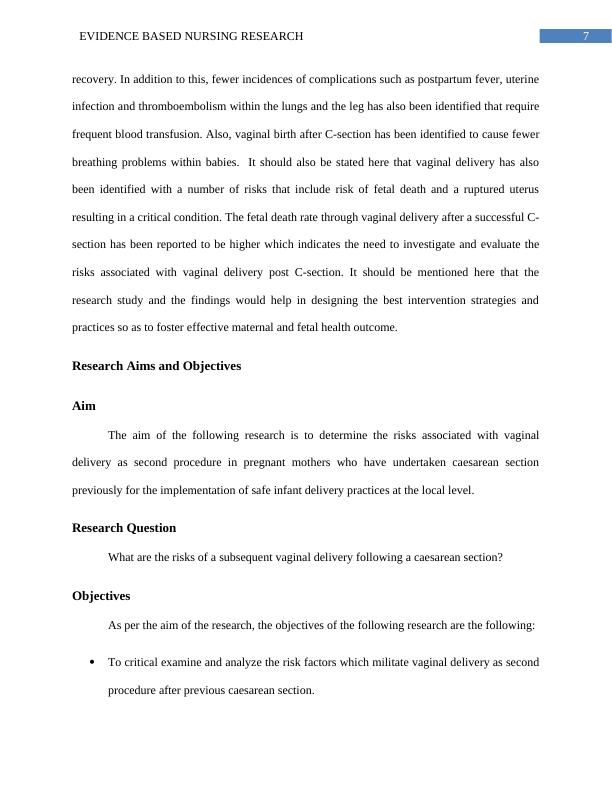
End of preview
Want to access all the pages? Upload your documents or become a member.
Related Documents
Concept of Caesarean Section (C-section) | Literature Reviewlg...
|12
|3008
|18
Evidence Based Nursing Researchlg...
|10
|2522
|254
2810NRS - Postnatal Care and Management Case Studylg...
|15
|4242
|121
Clinical Reasoning Cycle for Managing Post-Operative Complications in a Caesarean Section Patientlg...
|9
|2489
|345
Skin-to-Skin Contact between a mother and her new-bornlg...
|3
|465
|495
Evidence-Based Practiselg...
|5
|1245
|296
